 In my quest to track down other sources of tropical plants from within Puerto Rico, I stumbled onto the Montoso Gardens Website. The site has many photos and details about their effort. They also feature guided and unguided tours of the grounds.
In my quest to track down other sources of tropical plants from within Puerto Rico, I stumbled onto the Montoso Gardens Website. The site has many photos and details about their effort. They also feature guided and unguided tours of the grounds.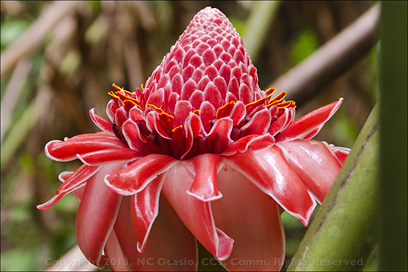
Sounds like a fun afternoon to me so I had to check it out.
After trading emails and meshing schedules, we set a date in late July. Though this part of the island at this time of year gets lots and lots of rain, we lucked out and had a wonderful day.
Montoso Gardens is owned and operated by Bryan Brunner and his brother Dave. Bryan is a horticulturist who works at the Agricultural Experimental Station of the University of Puerto Rico in Lajas. He moved to PR in 1987 to the mountains of Maricao and started with 9 acres. Over the years, he’s been able to expand the ‘little patch’ to 70 acres. 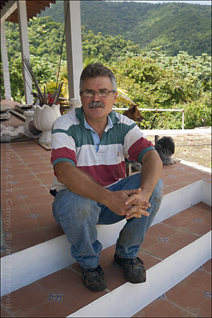 Dave joined the effort in 2001 and runs the day to day operations. A couple of great guys.
Dave joined the effort in 2001 and runs the day to day operations. A couple of great guys.
Their farm was originally part of the 137 acre coffee Hacienda el Cerro, and was owned by another horticulturist, Dr.  Frank Martin of the Tropical Agriculture Experimental Station (TARS) in Mayaguez.
Frank Martin of the Tropical Agriculture Experimental Station (TARS) in Mayaguez.
Getting there
Finding the place was not hard. It’s the same route we had covered to take in the Coffee Festival of Maricao which also took us past the observation overlook of la Torre de Piedra. The turnoff to Montoso Gardens was a few miles after that. If you plan to visit, their website has details about how to set up an appointment and how to find the place.
Basically, we exited Highway 2 at Sabana Grande and headed to town via Highway 121, then took Highway 120 out of town, into the mountains. We still managed to make the same wrong turn in town, but at least I knew where I needed to be.
It took right at 2 hours to make the trip from our place near Coamo to the gate at Montoso Gardens. There were roadside vendors selling Quenepa or Spanish Lime by the bunch, after we hit the other side of Ponce heading west. If you ever have the chance to try quenepa, do. Someday, my 2 little trees will produce. 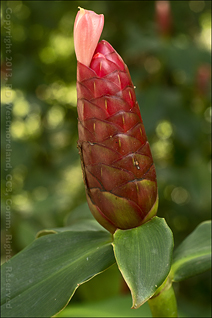
On the Grounds
Once we hooked up with Bryan, he took us down the road to the old coffee hacienda. It is in the process of being restored so it can be used by Eco-minded tourists for weekends and extended stays. Bryan has plans to eventually add a series of small bungalows to accommodate visitors. There are other plans to add key structures to the extensive paths that criss-cross the property. Foundations are in for part of it so they are making steady progress.
At the top where we were, they have a large plant nursery as well as a nice collection of bee hives. There is also a pretty good view up and down the valley from there. Their property borders the Maricao Forest Reserve with the Maricao River separating them.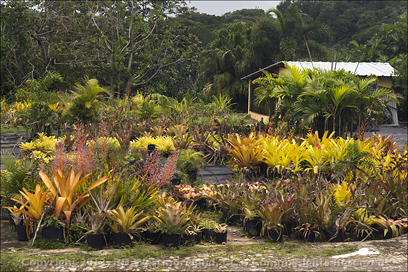 It’s hard to believe that the coast is just over that mountain range to the south.
It’s hard to believe that the coast is just over that mountain range to the south.
Before our ‘little’ trek down to the river, Bryan explained that they have added 600 varieties of fruit, nut and flowering plants to the gardens at last count.
Though I estimate it’s only a quarter mile to the river, it is somewhat steep. The path is wide and easy to walk, but I would still dress in good hiking shoes or boots to do it.
There was the occasional slick rock outcrop to avoid, but they were easy to spot.
My ankles are not what they used to be, but we made the trip down and back with just a couple of pauses. They plan to add benches to the paths and that would be most welcome. There are enough trails to check out that one would need a few days to see them all. What’s more, each path has it’s own unique vegetation.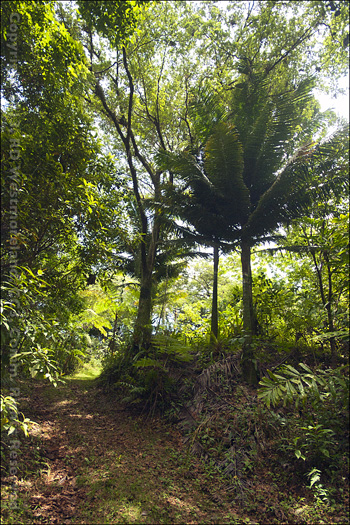
The Tour
Before I get started, I have to say, there is no way I can present everything we saw in our 2 hour tour. This will be the ‘highlights’ of the day. Note that many more and larger shots may be seen on our FaceBook page.
One of the great things about this trip is the abundance of mature trees and palms they have. It gave me a good idea as to what I could expect from my own little effort. ‘Little’ being the key word.
Before heading down, Bryan showed us several types of flowering Ceibas. They were stunning. There was also an example of a 10 year old African Oil palm. It was just beginning to show a trunk. They get quite big before that happens. I have one 4 footer I started from a seed I got from a 60(+) year old palm on the grounds of the Mayaguez Botanical Research Center. That was a huge, massive thing. One of the biggest palms I’ve ever seen. They just get bigger and bigger as time goes by.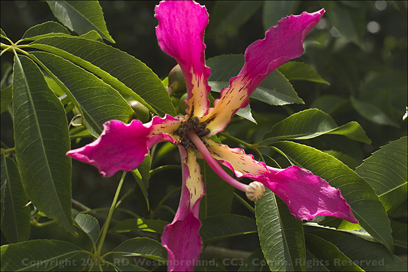
Our next stop was to check out a stand of Spanish Tamarind and lesser known Cohoba.
Spanish Tamarind, (Vangueria madagascariensis) is neither Spanish nor related to Tamarind, though there is similarity in the way you eat them. The fruit is usually allowed to dry on the tree and tastes like a cross between an apricot and a fig and only slightly astringent, somewhat pasty. As a novelty, I enjoyed it and intend to try and grow some.
The Cohoba (Anadenanthera peregrina) is a totally different thing. It’s a large tree that produces lots of dark brown bean pods. These were harvested by the Taino indians for use in ceremonial practices because the beans have hallucinogenic properties. 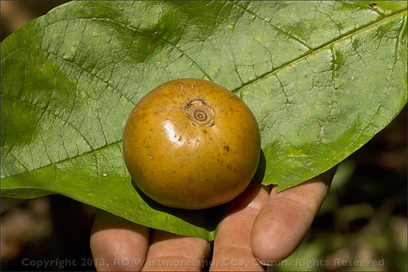 The trees were densely covered in spike like thorns and resin, even the young trees exuded an abundance of clear, amber colored sap. At a distance, the tree resembles a type of thorny Mimosa.
The trees were densely covered in spike like thorns and resin, even the young trees exuded an abundance of clear, amber colored sap. At a distance, the tree resembles a type of thorny Mimosa.
These would make nasty war clubs.
The Heliconia and Ginger Collections
Just down from there, we stopped to check out a collection of flowering Gingers. The shot of a dark rose colored cone-like flower with a single pink petal is edible. Bryan broke off the petal for us to try. It was delicious. It had a very mild, subtle flavor with absolutely no aftertaste. 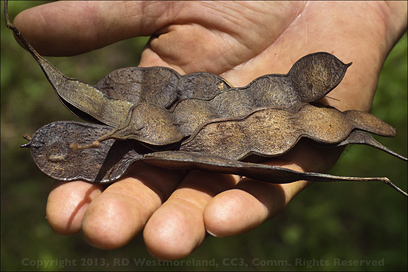 It would be perfect in a salad! Gingers grow everywhere so this would be an easy one to score. But be warned, only a few Gingers produce edible flowers or roots.
It would be perfect in a salad! Gingers grow everywhere so this would be an easy one to score. But be warned, only a few Gingers produce edible flowers or roots.
I love fruit and I like flowers, but the collection of Heliconias was outstanding. I could have spent a whole day, just shooting these. Being around them really makes you feel like you are in the middle of a tropical paradise and then it hits me- “I live here”!!
I’ve only had a few real ‘Indiana Jones’ type moments since I got to PR, but this was definitely one of them. And again, when we got down to the river.
It is so lush and green, down under the forest canopy.
Note to photographers- I hate using flash and avoid it when ever I can, but there are places where even ISO 3200 will just come out too flat. The light is too soft. So if you are serious about getting good shots, get friendly with your flash. (Note- When I first wrote this it came out ‘flask’. That might help too. Arrg!)![]()
Moving on from here put us in a small clearing, just before the river bordering the property. At the edge of the open field was a dense stand of bamboo (Bambusa vulgaris). They had the thickest culms I had ever seen. I guess lots of water really helps.
The path down to the river was only another 100 feet.
The stream was strewn with smooth boulders, large tree ferns and broken bamboo. A very picturesque moment with just enough light to do it justice. The water was crystal clear and cold… too cold to swim in. I would have had a drink if I had brought a cup.
This was our turnaround spot
We made our way back up via a different path. There were examples of a local pineapple growing in great clumps and Acai palms as well. The mature Acai had not produced fruit yet. It was great to see what my ‘babies’ might look like some day.
Moving on from there, Bryan pointed out several mature Kola Nut trees (Cola acuminata). A few still had seed pods hanging from them, but the rats were busy working over the shells. Not the seeds, however.
These trees are the ones that gave ‘Cola’ its name.
In Africa, some cultures still chew the raw seeds.
Up the path further was a collection of Salak Palms. This was a special treat for me as I have 9 Salak palm sprouts doing quite well. It was the first time I had seen them up close and personal. And these had fruits too!!! The thin scaly, paper like outside shell is easy to remove revealing a group of 3 to 5 fruit sections that resemble giant garlic cloves.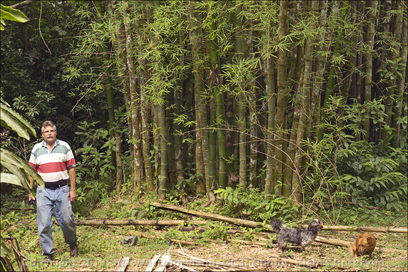 The larger sections contained a single seed with no more than 2 seeds per fruit.
The larger sections contained a single seed with no more than 2 seeds per fruit.
How did they taste you ask?
Like eating a crispy, crunchy green apple. Very sweet, somewhat tart, but very flavorful. I loved it. Admittedly, the first couple of bites were a little astringent, but that quickly faded. Salak will grow under a variety of conditions and propagate from both seeds and suckers. Bryan passed off the extra fruit to me to take home and I managed to score another 13 seeds out of the deal. If I can get all of that to come up, I’ll be set.
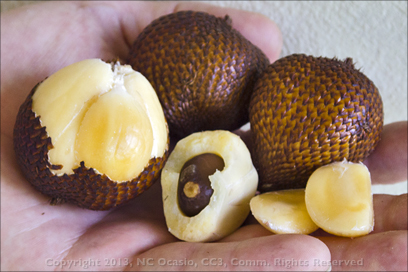 Salak palms are not all that popular to grow because of the 3 to 4 inch long needle like thorns they produce. Not good for high traffic areas.
Salak palms are not all that popular to grow because of the 3 to 4 inch long needle like thorns they produce. Not good for high traffic areas.
As we neared the top, I was getting pretty winded. I took that opportunity to pause and score a wide-angle shot, back down the path. You can just barely make out Bryan in the larger version of it. It helps define the scale.
After a short break at the top, we packed up the car and said our goodbyes as the next group was coming in. This is definitely a place I want to 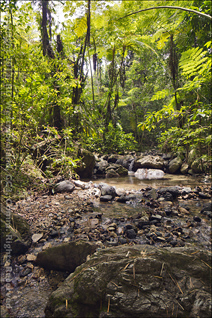 return to and spend more time shooting. We didn’t even get near the upper garden where there are more fruiting trees.
return to and spend more time shooting. We didn’t even get near the upper garden where there are more fruiting trees.
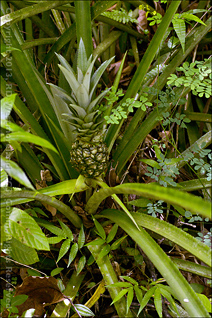 Out of 70 acres, we might have seen 4 of them. This is just the ‘tip of the iceberg’.
Out of 70 acres, we might have seen 4 of them. This is just the ‘tip of the iceberg’.
If one is looking for a break from ‘Crazyville’, this is the place to do it. Puerto Rico needs more sites like this for Eco-Tourists who don’t care about spas, golf or hanging out at the beach. The $5 tour is worth every dime. Diversity in activity can only be a good thing.
Montoso Gardens serves as a superb example.
A special thanks to me First Mate for the lead photo and a few others. ARRG!

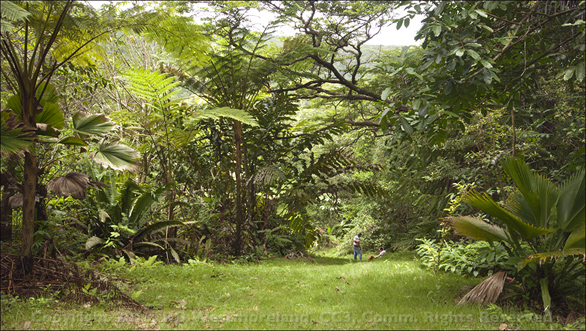
Erin says
I’m very interested in visiting Montoso Gardens on our upcoming visit. How long in advance did you have to book your tour? Thank you for all your great posts! This is the most interesting, informative English language blog on PR that I have found! (S. Dog- Thank you for the complements. Contact Bryan via his website or Facebook. He has many things for sale at very fair prices. Sadhu of Govardhan Gardens is also an excellent source for tropical plants.)